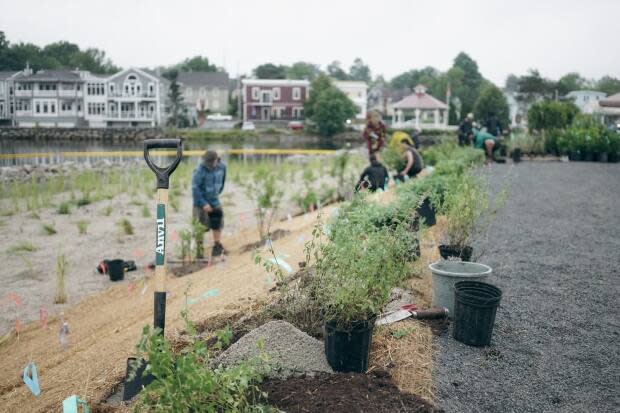Mahone Bay 'living shoreline' pilot project aims to reduce coastal erosion

Volunteers and an environmental organization have come together to help protect the scenic South Shore town of Mahone Bay from rising sea levels and storm surges caused by climate change.
A pilot project 'living shoreline' was installed along a 60-metre stretch of Edgewater Street in front of the town's iconic three churches. it was led by Mahone Bay-based environmental organization Coastal Action.
Samantha Battaglia, the climate change team lead at Coastal Action, told CBC Radio's Mainstreet NS that living shorelines can take many forms and incorporate a "suite of techniques" to minimize coastal erosion.
The Mahone Bay project includes rock sills, a tidal wetland and a vegetated bank, Battaglia said.
"The rock sills are hard engineering structures, and they run parallel to the shoreline and ... will help you to reduce wave energy and storm surge impacts," she said.
"In between the rock sills and the shoreline bank, we've installed a tidal wetland, and the tidal wetland is planted out with various perennials and native grasses."

According to Battaglia, the wetland will provide a valuable habitat for fish and bird species.
The third part of the project, the vegetated bank, is planted with various native shrubs and perennials and will help stabilize the soil, she said.
Storm surge impacts
Danika van Proosdij, a professor at Saint Mary's University and director of the TransCoastal Adaptation Centre for Nature-based Solutions, told Mainstreet NS host Jeff Douglas that section of Mahone Bay is at risk of storm surge impacts.
"It has experienced some as well heavy rainfall coming off of it and going over the parking lot surfaces also brings in a lot of runoff from that area," van Proosdij said.
"One of the other things that the living shoreline will do will help to reduce the silt coming into the harbour itself, to improve the water quality."
According to van Proosdij, the project also has the additional benefit of creating a more natural area which is aesthetically pleasing.
The ability of marshes to slow down wave energy has been known for some time, Van Proosdij said, and she is confident the project will prove effective.
Well established in 3 years
She said the installation will require some repairs and alterations for the first two years but by the third year the vegetation should have established itself and would be able to provide all its "protective and habitat and carbon sequestration functions."
Battaglia said about 55 volunteers came out over two days to plant 1,200 salt-tolerant native perennials and grasses in the intertidal area.
The community has been very supportive and, Battaglia said, the project was educational and helped ignite stewardship.

The project is based on a 2016 plan submitted by environmental design firm CBCL Ltd., according to Battaglia, but it took six years to get funding.
Funding for the project was eventually obtained from the Intact Foundation in 2020 and the installation was completed at the end of July.
Battaglia said the project is scalable along the entire shoreline next to Edgewater Street.
"We're hoping that this specific pilot project will help increase visibility of this project and understanding of nature-based solutions ... and help kick-start a much larger adaptation initiative along this entire 700 meter stretch in Mahone Bay Harbor."
MORE TOP STORIES


